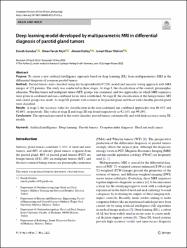| dc.contributor.author | Gündüz, Emrah | |
| dc.contributor.author | Alçin, Ömer Faruk | |
| dc.contributor.author | Kızılay, Ahmet | en_US |
| dc.contributor.author | Yıldırım, İsmail Okan | en_US |
| dc.date.accessioned | 2022-07-25T11:56:23Z | |
| dc.date.available | 2022-07-25T11:56:23Z | |
| dc.date.issued | 2022 | en_US |
| dc.identifier.uri | https://doi.org/10.1007/s00405-022-07455-y | |
| dc.identifier.uri | https://hdl.handle.net/20.500.12899/1178 | |
| dc.description | Received: 29 April 2022 / Accepted: 16 May 2022 | en_US |
| dc.description | Emrah Gunduz, Department of Otorhinolaryngology Head and Neck Surgery, Malatya Training and Research Hospital, Malatya, Turkey.
Omer Faruk Alçin, Department of Electric and Electronics Engineering Faculty of Engineering and Natural Sciences Malatya, Turgut Ozal University Malatya, Malatya, Turkey.
Ahmet Kizilay, Department of Otorhinolaryngology Head and Neck Surgery, Inonu University Faculty of Medicine, Malatya, 44000, Turkey.
Ismail Okan Yildirim, Department of Radiology, Inonu University Faculty of Medicine, Malatya, Turkey. | en_US |
| dc.description.abstract | Purpose: To create a new artificial intelligence approach based on deep learning (DL) from multiparametric MRI in the differential diagnosis of common parotid tumors. Methods: Parotid tumors were classified using the InceptionResNetV2 DL model and majority voting approach with MRI images of 123 patients. The study was conducted in three stages. At stage I, the classification of the control, pleomorphic adenoma, Warthin tumor and malignant tumor (MT) groups was examined, and two approaches in which MRI sequences were given in combined and non-combined forms were established. At stage II, the classification of the benign tumor, MT and control groups was made. At stage III, patients with a tumor in the parotid gland and those with a healthy parotid gland were classified. Results: A stage I, the accuracy value for classification in the non-combined and combined approaches was 86.43% and 92.86%, respectively. This value at stage II and stage III was found respectively as 92.14% and 99.29%. Conclusions: The approach presented in this study classifies parotid tumors automatically and with high accuracy using DL models. | en_US |
| dc.language.iso | en | en_US |
| dc.publisher | Springer | en_US |
| dc.relation.ispartof | European Archives of Oto-Rhino-Laryngology | en_US |
| dc.rights | info:eu-repo/semantics/closedAccess | en_US |
| dc.subject | Artifcial ıntelligence | en_US |
| dc.subject | Deep learning | en_US |
| dc.subject | Parotid tumors | en_US |
| dc.subject | Computer aided diagnosis | en_US |
| dc.subject | Head and neck cancer | en_US |
| dc.title | Deep learning model developed by multiparametric MRI in differential diagnosis of parotid gland tumors | en_US |
| dc.type | Article | en_US |
| dc.authorid | 0000-0002-2917-3736 | en_US |
| dc.department | MTÖ Üniversitesi, Tıp Fakültesi, Cerrahi Tıp Bilimleri Bölümü | en_US |
| dc.identifier.doi | 10.1007/s00405-022-07455-y | |
| dc.identifier.startpage | 1 | en_US |
| dc.identifier.endpage | 11 | en_US |
| dc.relation.publicationcategory | Makale - Uluslararası Hakemli Dergi - Kurum Öğretim Elemanı | en_US |
| dc.identifier.pmid | 35596805 | |
| dc.identifier.scopus | 2-s2.0-85130296080 | en_US |
| dc.indekslendigikaynak | Web of Science | en_US |
| dc.indekslendigikaynak | PubMed | en_US |


















